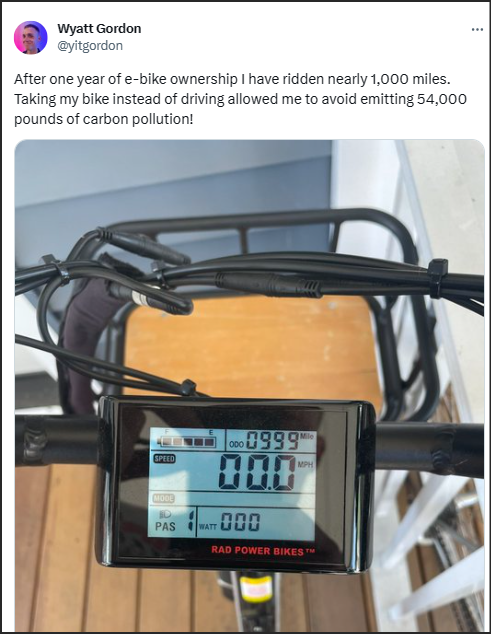by James A. Bacon
Wyatt Gordon writes about smart growth issues for the Virginia Mercury and Greater Greater Washington. Sometimes, he’s worth reading. But, then, sometimes, he’s not. As an example of the latter, he recently posted this on X, the social media platform formerly known as Twitter:
So, let me get this straight. If Gordon avoided emitting 54,000 pounds of carbon pollution by driving 1,000 miles on his electric bike instead of driving a car, he says he’s saving 54 pounds per mile. Is that physically possible?
Now, I never took high school chemistry, but I do know that a pound of gasoline does not translate into a pound of CO2 emissions. According to the EPA, when gasoline is combusted, it frees up carbon atoms and hydrogen atoms. The hydrogen atoms combine with oxygen atoms in the air to create water. The carbon atoms combine with oxygen atoms to create CO2. Most of the weight of a CO2 molecule comes from oxygen atoms that were not present in the gasoline. In that way, says the EPA, a gallon of gasoline does indeed transmute into about 20 pounds of tailpipe carbon.
But unless Gordon toodles around town in a monster truck, he’s likely getting 20 or more miles to the gallon. Basic arithmetic tells us that a car that gets 20 miles to the gallon consumes 1/20th of a gallon per mile. Therefore, it generates 1/2oth of a gallon’s worth of tailpipe carbon per mile… or about one pound.
Gordon appears to have overstated his reduced CO2 emissions by a factor of 50.
That’s not the scary part.
If people follow Gordon’s lead and start riding electric bikes, they’re not hurting anyone. They might even help reduce CO2 emissions (though at one 50th of the efficacy that Gordon suggests). What’s scary is this Twitter post.
Here’s what Next City says about itself: “Next City’s journalism centers marginalized voices while amplifying solutions to the problems that oppress people in cities.” VPM, of course, is Virginia Public Media.
Oh, great, one of the leading media properties in Virginia will disseminate the work of a journalist whose beat is “reparations and Virginia’s racial reckoning” — from a leftist perspective, of course.
Maybe that reporter will be better at arithmetic than Gordon, but I’m anticipating the usual misuse and abuse of statistics to “prove” the existence of systemic racism everywhere. The consequence will not be as harmless as converting people into electric bike riders. The constant drumbeat of “racism… racism… racism…” will engender an unjustified sense of grievance, victimhood and polarization that will do nothing to improve the lives of minorities — indeed, it will likely induce unproductive attitudes and behavior — but it will advance narratives that allow the predominantly White woke educational/cultural elite to bask in their superior virtue.



Leave a Reply
You must be logged in to post a comment.